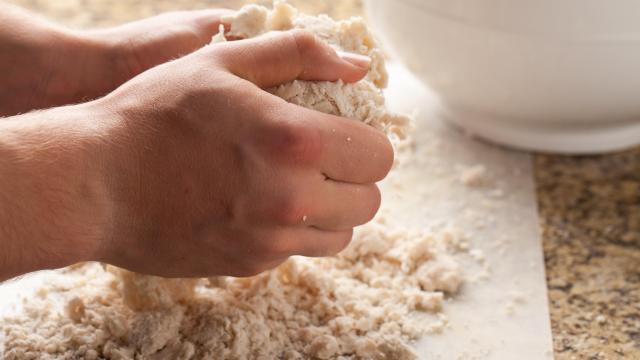Rolling out a flaky pie crust is a pain in the arse. It’s temperature sensitive, needs beauty rest in the fridge, and even under the best conditions, it might crack under pressure. Well, good news: You never need roll out another pie crust. You can stop the precarious transfer of dough from counter to pie plate. Instead of planning for the dreadful anxiety of repairing cracked dough, try one of these two methods for pressing in your pie crust. No rolling. No lifting. Just pour in the dough and smash.
Make a pâte sucrée crust
Pâte sucrée is a simple, sweet dough. It has a high content of fat and sugar, which makes it crumbly, buttery, and tender. Sound familiar? It’s the exact profile we’re looking for in pie crust. The granulated sugar content, along with a short gluten strand (thanks butter), allows for many breaking points in the dough, which means that although you can roll out this dough, it’s likely going to rip along those breaking points if you try to lift the entire sheet. That’s fine, you can easily fix the rips, but you can also just drop lumps of the dough into the pie plate and press it out. The structure of the dough will remain tender, and the high fat content allows you to seamlessly seal up any fissures by pressing them with your fingertips. Plus, it tastes like a cookie is cradling your pie filling.
Pâte sucrée is commonly made using the mealy method, which involves breaking up butter into the dry ingredients until it looks like sand. I usually use a stand mixer fitted with a paddle attachment to take care of that part. This process creates teeny tiny balls of butter and sugar, so even when you add the egg and splash of liquid to gently bind them, the pastry remains delicate. Once the dough is mixed, it will retain its crumbly yet damp nature. Place as much as you need in the pie dish and use a spatula or your fingers to press it out and up the sides of the plate. You can also use a flat bottomed measuring cup to help you press out the dough if it seems uneven. Bake as directed by the pie recipe you’re working with. Note that this is a sweet dough, best used with sweet pies. For a press-in crust that works with both sweet and savoury…
Use liquid fats
The problem with butter-based crusts is all the fussing with creating flakes. Flaky this and flaky that. Enough! Tender pastry doesn’t always require paper-thin layers of butter. You can make a short dough (short strands of gluten instead of the long, chewy ones seen in lean breads) with oil. Using an oil-based crust recipe, like this one from King Arthur, makes for the ultimate low-stress pie dough, and it happens to be a vegan option, too.
There’s no need to cut-in butter, rest your dough, or roll it out, this method is basically two main steps. Mix the dry ingredients in a large bowl, and whisk the oil and water together in a measuring cup. Pour the wet ingredients into the dry, and mix with a fork until combined. Pour the pastry into a pie dish and flatten with your implement of choice, be it the bottom of a jar or your fingertips. Convinced you’ll miss the buttery taste? You can modify this recipe by replacing the oil content with an equal amount of melted butter. Bake, or blind bake, according to the pie recipe’s directions.

Leave a Reply
You must be logged in to post a comment.